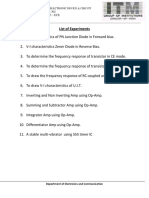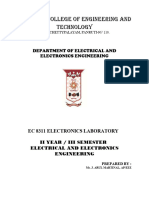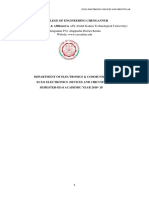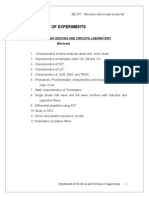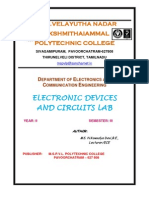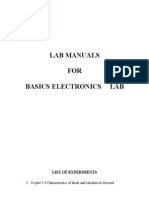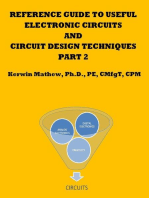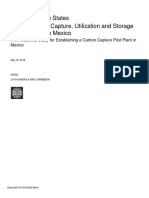EDC Lab Manual
Uploaded by
ranjitha gavniEDC Lab Manual
Uploaded by
ranjitha gavniBE LAB MANUAL
J.B.INSTITUTE OF ENGINEERING & TECHNOLOGY
Yenkapally, Moinabad (Mandal), Himayathnagar (post), Hydreabad-75
BASIC ELECTRONICS LAB
MANUAL
Department of Electronics & Communications
BY
V.V.V.S.Prasad
DEPARTMENT OF ECE, JBIET 1
BE LAB MANUAL
List of Experiments
1) P-N JUNCTION DIODE CHARACTERISTICS 03
2) ZENER DIODE CHARACTERISTICS 08
3. TRANSISTOR CB CHARACTERSTICS 14
4. TRANSISTOR CE CHARACTERSTICS 19
5. HALF WAVE RECTIFIER WITH & WITHOUT FILTER 25
6. FULL WAVE RECTIFIER WITH & WITHOUT FILTER 30
7. FET CHARACTERSITICS 35
8. MEASUREMENT OF h-PARAMETERS OF TRANSISTOR IN CB,
CE & CC CONFIGURATION 41
9. FREQUENCY RESPONSE OF CC AMPLIFIER 48
10 FREQUENCY RESPONSE OF CE AMPLIFIER 53
11. FREQUENCY RESPONSE OF COMMON SOURCE 59
FET AMPLIFIER
12. SCR CHARACTERISTICS 64
13 UJT CHARACTERSTICS
ADDITIONAL EXPERIMENTS:
14 BRIDGE RECTIFIER
15 RC COUPLED AMPLIFIER
DEPARTMENT OF ECE, JBIET 2
BE LAB MANUAL
1. P-N JUNCTION DIODE CHARACTERISTICS
AIM:-To observe and draw the Forward and Reverse bias V-I Characteristics of a P-N
Junction diode.
APPARATUS:-
P-N Diode IN4007.
Regulated Power supply (0-30v)
Resistor -1KΩ -1 no
Ammeters (0-20 mA, 0-500µA)
Voltmeter (0-5V,0-30 V)
Bread board
Connecting wires
THEORY:-
A p-n junction diode conducts only in one direction. The V-I
characteristics of the diode are curve between voltage across the diode and current
through the diode. When external voltage is zero, circuit is open and the potential barrier
does not allow the current to flow. Therefore, the circuit current is zero. When P-type
(Anode is connected to +ve terminal and n- type (cathode) is connected to –ve terminal of
the supply voltage, is known as forward bias. The potential barrier is reduced when diode
is in the forward biased condition. At some forward voltage, the potential barrier
altogether eliminated and current starts flowing through the diode and also in the circuit.
The diode is said to be in ON state. The current increases with increasing forward
voltage.
When N-type (cathode) is connected to +ve terminal and P-type
(Anode) is connected –ve terminal of the supply voltage is known as reverse bias and
the potential barrier across the junction increases. Therefore, the junction resistance
becomes very high and a very small current (reverse saturation current) flows in the
circuit. The diode is said to be in OFF state. The reverse bias current due to minority
charge carriers.
DEPARTMENT OF ECE, JBIET 3
BE LAB MANUAL
CIRCUIT DIAGRAM:-
FORWARD BIAS:-
REVERSE BIAS:-
DEPARTMENT OF ECE, JBIET 4
BE LAB MANUAL
MODEL WAVEFORM:-
PROCEDURE:-
FORWARD BIAS:-
1. Connections are made as per the circuit diagram.
2. For forward bias, the RPS +ve is connected to the anode of the diode and
RPS –ve is connected to the cathode of the diode,
3. Switch on the power supply and increases the input voltage (supply voltage) in
Steps.
4. Note down the corresponding current flowing through the diode and voltage
across the diode for each and every step of the input voltage.
5. The reading of voltage and current are tabulated.
6. Graph is plotted between voltage and current.
DEPARTMENT OF ECE, JBIET 5
BE LAB MANUAL
OBSERVATION:-
S.NO VOLTAGE ACROSS CURRENT
DIODE(V) THROUGH
DIODE(mA)
PROCEDURE:-
REVERSE BIAS:-
1. Connections are made as per the circuit diagram
2 . For reverse bias, the RPS +ve is connected to the cathode of the diode and
RPS –ve is connected to the anode of the diode.
3. Switch on the power supply and increase the input voltage (supply voltage) in
Steps
4. Note down the corresponding current flowing through the diode voltage
across the diode for each and every step of the input voltage.
5. The readings of voltage and current are tabulated
6. Graph is plotted between voltage and current.
OBSERVATION:-
DEPARTMENT OF ECE, JBIET 6
BE LAB MANUAL
S.NO APPLIEDVOLTAGE VOLTAGE CURRENT
ACROSSDIODE(V) ACROSS THROUGH
DIODE(V) DIODE(mA)
PRECAUTIONS:-
1. All the connections should be correct.
2. Parallax error should be avoided while taking the readings from the Analog meters.
RESULT:- Forward and Reverse Bias characteristics for a p-n diode is observed
VIVA QESTIONS:-
1. Define depletion region of a diode?
2. What is meant by transition & space charge capacitance of a diode?
3. Is the V-I relationship of a diode Linear or Exponential?
4. Define cut-in voltage of a diode and specify the values for Si and Ge diodes?
5. What are the applications of a p-n diode?
6. Draw the ideal characteristics of P-N junction diode?
7. What is the diode equation?
DEPARTMENT OF ECE, JBIET 7
BE LAB MANUAL
8. What is PIV?
9. What is the break down voltage?
10. What is the effect of temperature on PN junction diodes?
2. ZENER DIODE CHARACTERISTICS
AIM: - a) To observe and draw the static characteristics of a zener diode
b) To find the voltage regulation of a given zener diode
APPARATUS: -
Zener diode.
Regulated Power Supply (0-30v).
Voltmeter (0-20v)
Ammeter (0-100mA)
Resistor (1KOhm)
Bread Board
Connecting wires
CIRCUIT DIAGRAM:-
DEPARTMENT OF ECE, JBIET 8
BE LAB MANUAL
STATIC CHARACTERISTICS:-
DEPARTMENT OF ECE, JBIET 9
BE LAB MANUAL
REGULATION CHARACTERISTICS:-
Theory:-
A zener diode is heavily doped p-n junction diode, specially made to
operate in the break down region. A p-n junction diode normally does not conduct when
reverse biased. But if the reverse bias is increased, at a particular voltage it starts
conducting heavily. This voltage is called Break down Voltage. High current through the
diode can permanently damage the device
To avoid high current, we connect a resistor in series with zener diode.
Once the diode starts conducting it maintains almost constant voltage across the
terminals what ever may be the current through it, i.e., it has very low dynamic
resistance. It is used in voltage regulators.
PROCEDURE:-
Static characteristics:-
1. Connections are made as per the circuit diagram.
2. The Regulated power supply voltage is increased in steps.
3. The zener current (lz), and the zener voltage (Vz.) are observed and then
noted in the tabular form.
4. A graph is plotted between zener current (Iz) and zener voltage (Vz).
DEPARTMENT OF ECE, JBIET 10
BE LAB MANUAL
Regulation characteristics:-
1. The voltage regulation of any device is usually expressed as percentage regulation
2. The percentage regulation is given by the formula
((VNL-VFL)/VFL)X100
VNL=Voltage across the diode, when no load is connected.
VFL=Voltage across the diode, when load is connected.
3. Connection are made as per the circuit diagram
4. The load is placed in full load condition and the zener voltage (Vz), Zener current
(lz), load current (IL) are measured.
5. The above step is repeated by decreasing the value of the load in steps.
6. All the readings are tabulated.
7. The percentage regulation is calculated using the above formula
OBSERVATIONS:-
Static characteristics:-
S.NO ZENER ZENER
VOLTAGE(VZ) CURRENT(IZ)
REGULATION CHARACTERISTICS:-
DEPARTMENT OF ECE, JBIET 11
BE LAB MANUAL
S. VNL(VOLTS) VFL RL %
N0 (VOLTS) (KΏ) REGULATION
MODEL WAVEFORMS:-
PRECAUTIONS:-
DEPARTMENT OF ECE, JBIET 12
BE LAB MANUAL
1. The terminals of the zener diode should be properly identified
2. While determined the load regulation, load should not be immediately shorted.
3. Should be ensured that the applied voltages & currents do not exceed the ratings of
the diode.
RESULT:-
a) Static characteristics of zener diode are obtained and drawn.
b) Percentage regulation of zener diode is calculated.
VIVAQUESTIONS:-
1. What type of temp Coefficient does the zener diode have?
2. If the impurity concentration is increased, how the depletion width effected?
3. Does the dynamic impendence of a zener diode vary?
4. Explain briefly about avalanche and zener breakdowns?
5. Draw the zener equivalent circuit?
6. Differentiate between line regulation & load regulation?
7. In which region zener diode can be used as a regulator?
8. How the breakdown voltage of a particular diode can be controlled?
9. What type of temperature coefficient does the Avalanche breakdown has?
10. By what type of charge carriers the current flows in zener and avalanche breakdown
diodes?
DEPARTMENT OF ECE, JBIET 13
BE LAB MANUAL
3. TRANSISTOR COMMON -BASE CONFIGURATION
AIM: 1.To observe and draw the input and output characteristics of a transistor
connected in common base configuration.
2. To find α of the given transistor.
APPARATUS: Transistor, BC 107
Regulated power supply (0-30V, 1A)
Voltmeter (0-20V)
Ammeters (0-100mA)
Resistor, 1000Ω
Bread board
Connecting wires
THEORY:
A transistor is a three terminal active device. T he terminals are emitter, base,
collector. In CB configuration, the base is common to both input (emitter) and output
(collector). For normal operation, the E-B junction is forward biased and C-B junction
is reverse biased.
In CB configuration, IE is +ve, IC is –ve and IB is –ve. So,
VEB=f1 (VCB,IE) and
IC=f2 (VCB,IB)
With an increasing the reverse collector voltage, the space-charge width at the
output junction increases and the effective base width ‘W’ decreases. This phenomenon
is known as “Early effect”. Then, there will be less chance for recombination within the
base region. With increase of charge gradient with in the base region, the current of
minority carriers injected across the emitter junction increases.The current amplification
factor of CB configuration is given by,
α= ∆IC/ ∆IE
CIRCUIT DIAGRAM
DEPARTMENT OF ECE, JBIET 14
BE LAB MANUAL
PROCEDURE:
INPUT CHARACTERISTICS:
1. Connections are made as per the circuit diagram.
2. For plotting the input characteristics, the output voltage VCE is kept constant at 0V
and for different values of VEB note down the values of IE.
3. Repeat the above step keeping VCB at 2V, 4V, and 6V.All the readings are tabulated.
4. A graph is drawn between VEB and IE for constant VCB.
OUTPUT CHARACTERISTICS:
1. Connections are made as per the circuit diagram.
2. For plotting the output characteristics, the input I E iskept constant at 10m A and for
different values of VCB, note down the values of IC.
3. Repeat the above step for the values of I E at 20 mA, 40 mA, and 60 mA, all the
readings are tabulated.
4. A graph is drawn between VCB and Ic for constant IE
OBSERVATIONS:
INPUT CHARACTERISTICS:
DEPARTMENT OF ECE, JBIET 15
BE LAB MANUAL
S.No VCB=0V VCB=1V VCB=2V
VEB(V) IE(mA) VEB(V) IE(mA) VEB(V) IE(mA)
OUTPUT CHARACTERISTICS:
IE=10mA IE=20mA IE=30mA
S.No
VCB(V) IC(mA) VCB(V) IC(mA) VCB(V) IC(mA)
MODEL GRAPHS:
INPUT CHARACTERISTICS
DEPARTMENT OF ECE, JBIET 16
BE LAB MANUAL
OUTPUT CHARACTERISTICS
PRECAUTIONS:
1. The supply voltages should not exceed the rating of the transistor.
DEPARTMENT OF ECE, JBIET 17
BE LAB MANUAL
2. Meters should be connected properly according to their polarities.
RESULT:
1. The input and output characteristics of the transistor are drawn.
2. The α of the given transistor is calculated.
VIVA QUESTIONS:
1. What is the range of α for the transistor?
2. Draw the input and output characteristics of the transistor in CB configuration?
3. Identify various regions in output characteristics?
4. What is the relation between α and β?
5. What are the applications of CB configuration?
6. What are the input and output impedances of CB configuration?
7. Define α(alpha)?
8. What is EARLY effect?
9. Draw diagram of CB configuration for PNP transistor?
10. What is the power gain of CB configuration?
DEPARTMENT OF ECE, JBIET 18
BE LAB MANUAL
4. TRANSISTOR CE CHARACTERSTICS
AIM: 1. To draw the input and output characteristics of transistor connected in
CE configuration
2. To find β of the given transistor.
APPARATUS:
Transistor (BC 107)
R.P.S (O-30V) 2Nos
Voltmeters (0-20V) 2Nos
Ammeters (0-200μA)
(0-500mA)
Resistors 1Kohm
Bread board
THEORY:
A transistor is a three terminal device. The terminals are emitter, base,
collector. In common emitter configuration, input voltage is applied between base and
emitter terminals and out put is taken across the collector and emitter terminals.
Therefore the emitter terminal is common to both input and output.
The input characteristics resemble that of a forward biased diode curve. This
is expected since the Base-Emitter junction of the transistor is forward biased. As
compared to CB arrangement IB increases less rapidly with VBE . Therefore input
resistance of CE circuit is higher than that of CB circuit.
The output characteristics are drawn between I c and VCE at constant IB. the
collector current varies with VCE unto few volts only. After this the collector current
becomes almost constant, and independent of VCE. The value of VCE up to which the
collector current changes with V CE is known as Knee voltage. The transistor always
operated in the region above Knee voltage, I C is always constant and is approximately
equal to IB.
The current amplification factor of CE configuration is given by
Β = ΔIC/ΔIB
CIRCUIT DIAGRAM:
DEPARTMENT OF ECE, JBIET 19
BE LAB MANUAL
PROCEDURE:
INPUT CHARECTERSTICS:
1. Connect the circuit as per the circuit diagram.
2. For plotting the input characteristics the output voltage VCE is kept constant at 1V
and for different values of VBE . Note down the values of IC
3. Repeat the above step by keeping VCE at 2V and 4V.
4. Tabulate all the readings.
5. plot the graph between VBE and IB for constant VCE
OUTPUT CHARACTERSTICS:
1. Connect the circuit as per the circuit diagram
2. for plotting the output characteristics the input current I B is kept constant at
10μA and for different values of VCE note down the values of IC
3. repeat the above step by keeping IB at 75 μA 100 μA
4. tabulate the all the readings
5. plot the graph between VCE and IC for constant IB
DEPARTMENT OF ECE, JBIET 20
BE LAB MANUAL
OBSERVATIONS:
INPUT CHARACTERISTICS:
VCE = 1V VCE = 2V VCE = 4V
S.NO
VBE(V) IB(μA) VBE(V) IB(μA) VBE(V) IB(μA)
OUT PUT CHARACTERISTICS:
IB = 50 μA IB = 75 μA IB = 100 μA
S.NO
VCE(V) IC(mA) VCE(V) ICmA) VCE(V) IC(mA)
DEPARTMENT OF ECE, JBIET 21
BE LAB MANUAL
MODEL GRAPHS:
INPUT CHARACTERSTICS:
OUTPUT CHARECTERSTICS:
DEPARTMENT OF ECE, JBIET 22
BE LAB MANUAL
PRECAUTIONS:
1. The supply voltage should not exceed the rating of the transistor
2. Meters should be connected properly according to their polarities
RESULT:
1. the input and out put characteristics of a transistor in CE configuration are Drawn
2. the of a given transistor is calculated
VIVA QUESTIONS:
1. What is the range of for the transistor?
2. What are the input and output impedances of CE configuration?
3. Identify various regions in the output characteristics?
4. what is the relation between and
5. Define current gain in CE configuration?
6. Why CE configuration is preferred for amplification?
7. What is the phase relation between input and output?
8. Draw diagram of CE configuration for PNP transistor?
9. What is the power gain of CE configuration?
10. What are the applications of CE configuration?
DEPARTMENT OF ECE, JBIET 23
BE LAB MANUAL
5. HALF – WAVE RECTIFIER
AIM: - To obtain the load regulation and ripple factor of a half-rectifier.
1. with Filter
2. without Filter
APPARATUS:-
Experimental Board
Multimeters –2No’s.
Transformer (6-0-6).
Diode, 1N 4007
Capacitor 100μf.
Resistor 1KΩ.
Connecting wires
THEORY: -
During positive half-cycle of the input voltage, the diode D1 is in forward bias
and conducts through the load resistor R1. Hence the current produces an output voltage
across the load resistor R1, which has the same shape as the +ve half cycle of the input
voltage.
During the negative half-cycle of the input voltage, the diode is reverse biased
and there is no current through the circuit. i.e, the voltage across R1 is zero. The net
result is that only the +ve half cycle of the input voltage appears across the load. The
average value of the half wave rectified o/p voltage is the value measured on dc
voltmeter.
For practical circuits, transformer coupling is usually provided for two
reasons.
1. The voltage can be stepped-up or stepped-down, as needed.
2. The ac source is electrically isolated from the rectifier. Thus preventing shock
hazards in the secondary circuit.
DEPARTMENT OF ECE, JBIET 24
BE LAB MANUAL
CIRCUIT DIAGRAM:-
PROCEDURE:-
1. Connections are made as per the circuit diagram.
2. Connect the primary side of the transformer to ac mains and the secondary side to the
rectifier input.
3. By the multimeter, measure the ac input voltage of the rectifier and, ac and dc voltage
at the output of the rectifier.
4. Find the theoretical of dc voltage by using the formula,
Vdc=Vm/П
Where, Vm=2Vrms, (Vrms=output ac voltage.)
The Ripple factor is calculated by using the formula
r=ac output voltage/dc output voltage.
DEPARTMENT OF ECE, JBIET 25
BE LAB MANUAL
REGULATION CHARACTERSTICS:-
1. Connections are made as per the circuit diagram.
2. By increasing the value of the rheostat, the voltage across the load and current
flowing through the load are measured.
3. The reading is tabulated.
4. Draw a graph between load voltage (VL and load current ( IL ) taking VL on X-
axis and IL on y-axis
5. From the value of no-load voltages, the %regulation is calculated using the
formula,
Theoretical calculations for Ripple factor:-
Without Filter:-
Vrms=Vm/2
Vm=2Vrms
Vdc=Vm/П
Ripple factor r=√ (Vrms/ Vdc )2 -1 =1.21
With Filter:-
Ripple factor, r=1/ (2√3 f C R)
Where f =50Hz
C =100µF
RL=1KΩ
PRACTICAL CALCULATIONS:-
Vac=
Vdc=
Ripple factor with out Filter =
Ripple factor with Filter =
DEPARTMENT OF ECE, JBIET 26
BE LAB MANUAL
OBSERVATIONS:-
WITHOUT FILTER
USING Vac(v) Vdc(v) r= Vac/ Vdc
DMM
WITH FILTER
USING Vac(v) Vdc(v) r= Vac/ Vdc
DMM
WITHOUTFILTER:-
Vdc=Vm/П, Vrms=Vm/2, Vac=√ ( Vrms2- Vdc 2)
Vm(v) Vac(v) Vdc(v) r= Vac/ Vdc
USING
CRO
WITHFILTER
V1(V) V2(V) Vdc= Vac= r=
USINGCRO (V1+V2)/2 (V1- V2)/2√3 Vac/
Vdc
DEPARTMENT OF ECE, JBIET 27
BE LAB MANUAL
PRECAUTIONS:
1. The primary and secondary sides of the transformer should be carefully identified.
2. The polarities of the diode should be carefully identified.
3. While determining the % regulation, first Full load should be applied and then it
should be decremented in steps.
RESULT:-
1. The Ripple factor for the Half-Wave Rectifier with and without filters is measured.
2. The % regulation of the Half-Wave rectifier is calculated.
VIVA QUESTIONS:
1. What is the PIV of Half wave rectifier?
2. What is the efficiency of half wave rectifier?
3. What is the rectifier?
4. What is the difference between the half wave rectifier and full wave
Rectifier?
5. What is the o/p frequency of Bridge Rectifier?
6. What are the ripples?
7. What is the function of the filters?
8. What is TUF?
9. What is the average value of o/p voltage for HWR?
10. What is the peak factor?
DEPARTMENT OF ECE, JBIET 28
BE LAB MANUAL
6. FULL-WAVE RECTIFIER
AIM:-To find the Ripple factor and regulation of a Full-wave Rectifier with and
without filter.
APPARATUS:-
Experimental Board
Transformer (6-0-6v).
P-n Diodes, (lN4007) ---2 No’s
Multimeters –2No’s
Filter Capacitor (100μF/25v) -
Connecting Wires
Load resistor, 1KΩ
THEORY:-
The circuit of a center-tapped full wave rectifier uses two diodes
D1&D2. During positive half cycle of secondary voltage (input voltage), the diode D1
is forward biased and D2is reverse biased.
The diode D1 conducts and current flows through load resistor RL. During
negative half cycle, diode
D2 becomes forward biased and D1 reverse biased. Now, D2 conducts and
current flows through the load resistor RL in the same direction. There is a continuous
current flow through the load resistor R L, during both the half cycles and will get
unidirectional current as show in the model graph. The difference between full wave
and half wave rectification is that a full wave rectifier allows unidirectional (one way)
current to the load during the entire 360 degrees of the input signal and half-wave
rectifier allows this only during one half cycle (180 degree).
DEPARTMENT OF ECE, JBIET 29
BE LAB MANUAL
CIRCUIT DIAGRAM:-
PROCEDURE:
1. Connections are made as per the circuit diagram.
3. Connect the ac mains to the primary side of the transformer and the secondary
side to the rectifier.
4. Measure the ac voltage at the input side of the rectifier.
5. Measure both ac and dc voltages at the output side the rectifier.
DEPARTMENT OF ECE, JBIET 30
BE LAB MANUAL
6. Find the theoretical value of the dc voltage by using the formula Vdc=2Vm/П
7. Connect the filter capacitor across the load resistor and measure the values of Vac
and Vdc at the output.
8. The theoretical values of Ripple factors with and without capacitor are calculated.
9. From the values of Vac and Vdc practical values of Ripple factors are calculated.
The practical values are compared with theoretical values.
THEORITICAL CALCULATIONS:-
Vrms = Vm/ √2
Vm =Vrms√2
Vdc=2Vm/П
(i)Without filter:
Ripple factor, r = √ ( Vrms/ Vdc )2 -1 = 0.482
(ii)With filter:
Ripple factor, r = 1/ (4√3 f C RL) where f =50Hz
C =100µF
RL=1KΩ
PRACTICAL CALCULATIONS:
Without filter:-
Vac=
Vdc=
Ripple factor, r=Vac/Vdc
With filters:-
Vac=
Vdc=
Ripple factor=Vac/Vdc
DEPARTMENT OF ECE, JBIET 31
BE LAB MANUAL
Without Filter:
USING Vac(v) Vdc(v) r= Vac/ Vdc
DMM
With Filter
USING Vac(v) Vdc(v) r= Vac/ Vdc
DMM
Without Filter
Vrms = Vm/ √2 , Vdc=2Vm/П , Vac=√( Vrms2- Vdc 2)
Vm(v) Vac(v) Vdc(v) r= Vac/ Vdc
USING
CRO
With Filter
V1(V) V2(V) Vdc= Vac= r=
USINGCRO (V1+V2)/2 (V1- Vac/
V2)/2√3 Vdc
PRECAUTIONS:
DEPARTMENT OF ECE, JBIET 32
BE LAB MANUAL
1. The primary and secondary side of the transformer should be carefully identified
2. The polarities of all the diodes should be carefully identified.
RESULT:-
The ripple factor of the Full-wave rectifier (with filter and without filter) is calculated.
VIVA QUESTIONS:-
1. Define regulation of the full wave rectifier?
2. Define peak inverse voltage (PIV)? And write its value for Full-wave rectifier?
3. If one of the diode is changed in its polarities what wave form would you get?
4. Does the process of rectification alter the frequency of the waveform?
5. What is ripple factor of the Full-wave rectifier?
6. What is the necessity of the transformer in the rectifier circuit?
7. What are the applications of a rectifier?
8. What is ment by ripple and define Ripple factor?
9. Explain how capacitor helps to improve the ripple factor?
10. Can a rectifier made in INDIA (V=230v, f=50Hz) be used in USA (V=110v,
f=60Hz)?
DEPARTMENT OF ECE, JBIET 33
BE LAB MANUAL
7. FET CHARACTERISTICS
AIM: a). To draw the drain and transfer characteristics of a given
FET.
b). To find the drain resistance (rd) amplification factor (μ) and
Tran conductance (gm) of the given FET.
APPARATUS: FET (BFW-11)
Regulated power supply
Voltmeter (0-20V)
Ammeter (0-100mA)
Bread board
Connecting wires
THEORY:
A FET is a three terminal device, having the characteristics of high input impedance
and less noise, the Gate to Source junction of the FET s always reverse biased. In
response to small applied voltage from drain to source, the n-type bar acts as sample
resistor, and the drain current increases linearly with V DS. With increase in ID the ohmic
voltage drop between the source and the channel region reverse biases the junction and
the conducting position of the channel begins to remain constant. The VDS at this instant
is called “pinch of voltage”.
If the gate to source voltage (V GS) is applied in the direction to provide
additional reverse bias, the pinch off voltage ill is decreased.
In amplifier application, the FET is always used in the region beyond the
pinch-off.
FDS=IDSS(1-VGS/VP)^2
DEPARTMENT OF ECE, JBIET 34
BE LAB MANUAL
CIRCUIT DIAGRAM
PROCEDURE:
1. All the connections are made as per the circuit diagram.
2. To plot the drain characteristics, keep VGS constant at 0V.
3. Vary the VDD and observe the values of VDS and ID.
4. Repeat the above steps 2, 3 for different values of VGS at 0.1V and 0.2V.
5. All the readings are tabulated.
6. To plot the transfer characteristics, keep VDS constant at 1V.
7. Vary VGG and observe the values of VGS and ID.
DEPARTMENT OF ECE, JBIET 35
BE LAB MANUAL
8. Repeat steps 6 and 7 for different values of VDS at 1.5 V and 2V.
9. The readings are tabulated.
10. From drain characteristics, calculate the values of dynamic resistance (rd) by using
the formula
rd = ∆VDS/∆ID
11. From transfer characteristics, calculate the value of transconductace (g m) By using
the formula Gm=∆ID/∆VDS
12. Amplification factor (μ) = dynamic resistance. Tran conductance
μ = ∆VDS/∆VGS
OBSERVATIONS:
DRAIN CHARACTERISTICS:
S.NO VGS=0V VGS=0.1V VGS=0.2V
VDS(V) ID(mA) VDS(V) ID(mA) VDS(V) ID(mA)
TRANSFER CHARACTERISTICS:
S.NO VDS VDS=1V VDS
=0.5V =1.5V
VGS (V) ID(mA) VGS (V) ID(mA) VGS (V) ID(mA)
DEPARTMENT OF ECE, JBIET 36
BE LAB MANUAL
MODEL GRAPH:
TRANSFER CHARACTERISTICS
DRAIN CHARACTERISTICS
DEPARTMENT OF ECE, JBIET 37
BE LAB MANUAL
PRECAUTIONS:
1. The three terminals of the FET must be care fully identified
2. Practically FET contains four terminals, which are called source, drain, Gate,
substrate.
3. Source and case should be short circuited.
4. Voltages exceeding the ratings of the FET should not be applied.
RESULT :
1. The drain and transfer characteristics of a given FET are drawn
2. The dynamic resistance (rd), amplification factor (μ) and Tran conductance (gm)
of the given FET are calculated.
VIVA QUESTIONS:
1. What are the advantages of FET?
2. Different between FET and BJT?
DEPARTMENT OF ECE, JBIET 38
BE LAB MANUAL
3. Explain different regions of V-I characteristics of FET?
4. What are the applications of FET?
5. What are the types of FET?
6. Draw the symbol of FET.
7. What are the disadvantages of FET?
8. What are the parameters of FET?
DEPARTMENT OF ECE, JBIET 39
BE LAB MANUAL
8. h-PARAMETERS OF CE CONFIGURATION
AIM: To calculate the H-parameters of transistor in CE configuration.
APPRATUS: Transistor BC 107
Resistors 100 K Ώ 100 Ώ
Ammeter (0-200µA), (0-200mA)
Voltmeter (0-20V) - 2Nos
Regulated Power Supply (0-30V, 1A) - 2Nos
Breadboard
THEORY:
INPUT CHARACTERISTICS:
The two sets of characteristics are necessary to describe the behavior of
the CE configuration one for input or base emitter circuit and other for the output or
collector emitter circuit.
In input characteristics the emitter base junction forward biased by a
very small voltage VBB where as collector base junction reverse biased by a very large
voltage VCC. The input characteristics are a plot of input current I B Vs the input voltage
VBE for a range of values of output voltage V CE . The following important points can be
observed from these characteristics curves.
1. The characteristics resemble that of CE configuration.
2. Input resistance is high as IB increases less rapidly with VBE
3. The input resistance of the transistor is the ratio of change in base emitter voltage
ΔVBE to change in base current ΔIB at constant collector emitter voltage ( VCE) i.e...
Input resistance or input impedance hie = ΔVBE / ΔIB at VCE constant.
DEPARTMENT OF ECE, JBIET 40
BE LAB MANUAL
OUTPUT CHARACTERISTICS:
A set of output characteristics or collector characteristics are a plot of out
put current IC VS output voltage VCE for a range of values of input current IB .The
following important points can be observed from these characteristics curves:-
1. The transistor always operates in the active region. I.e. the collector current
I C increases with VCE very slowly. For low values of the V CE the IC increases
rapidly with a small increase in VCE .The transistor is said to be working in saturation
region.
Output resistance is the ratio of change of collector emitter voltage ΔV CE , to
change in collector current ΔIC with constant IB. Output resistance or Output impedance
hoe = ΔVCE / ΔIC at IB constant.
Input Impedance hie = ΔVBE / ΔIB at VCE constant
Output impedance hoe = ΔVCE / ΔIC at IB constant
Reverse Transfer Voltage Gain hre = ΔVBE / ΔVCE at IB constant
Forward Transfer Current Gain hfe = ΔIC / ΔIB at constant VCE
DEPARTMENT OF ECE, JBIET 41
BE LAB MANUAL
CIRCUIT DIAGRAM:
PROCEDURE:
1. Connect a transistor in CE configuration circuit for plotting its input and output
characteristics.
2. Take a set of readings for the variations in IB with VBE at different fixed values of
output voltage VCE .
3. Plot the input characteristics of CE configuration from the above readings.
4. From the graph calculate the input resistance hie and reverse transfer ratio hre by
taking the slopes of the curves.
5. Take the family of readings for the variations of I C with VCE at different values of
fixed IB.
6. Plot the output characteristics from the above readings.
7. From the graphs calculate hfe ands hoe by taking the slope of the curves.
DEPARTMENT OF ECE, JBIET 42
BE LAB MANUAL
Tabular Forms
Input Characteristics
VCE=0V VCE=4V
S.NO
VBE(V) IB(μA) VBE(V) IB(μA)
Output Characteristics
IB = 20 µA IB = 40 µA IB = 60 µA
S.NO
VCE (V) IC(mA) VCE (V) IC(mA) VCE (V) IC(mA)
M
O D
E L
WAVEFORM:
Input Characteristics
DEPARTMENT OF ECE, JBIET 43
BE LAB MANUAL
Output Characteristics
DEPARTMENT OF ECE, JBIET 44
BE LAB MANUAL
RESULT:
The H-Parameters for a transistor in CE configuration are calculated from the input and
output characteristics.
1. Input Impedance hie =
2. Reverse Transfer Voltage Gain hre =
3. Forward Transfer Current Gain hfe =
4. Output conductance hoe =
VIVA QUESTIONS:
1. What are the h-parameters?
2. What are the limitations of h-parameters?
3. What are its applications?
4. Draw the Equivalent circuit diagram of H parameters?
5. Define H parameter?
6. What are tabular forms of H parameters monoculture of a transistor?
7. What is the general formula for input impedance?
8. What is the general formula for Current Gain?
9. What is the general formula for Voiltage gain?
DEPARTMENT OF ECE, JBIET 45
BE LAB MANUAL
9. COMMON COLLECTOR AMPLIFIER
AIM: 1. To measure the voltage gain of a CC amplifier
2. To draw the frequency response of the CC amplifier
APPRATUS:
Transistor BC 107
Regulated Power Supply (0-30V)
Function Generator
CRO
Resistors 33KΩ, 3.3KΩ, 330Ω, 1.5KΩ, 1KΩ, 2.2KΩ & 4.7KΩ
Capacitors 10µF -2Nos
100µF
Breadboard
Connecting wires
THEORY:
In common-collector amplifier the input is given at the base and the output is
taken at the emitter. In this amplifier, there is no phase inversion between input and
output. The input impedance of the CC amplifier is very high and output impedance is
low. The voltage gain is less than unity. Here the collector is at ac ground and the
capacitors used must have a negligible reactance at the frequency of operation.
This amplifier is used for impedance matching and as a buffer amplifier.
This circuit is also known as emitter follower.
DEPARTMENT OF ECE, JBIET 46
BE LAB MANUAL
CIRCUIT DIAGRAM:
PROCEDURE:
1. Connections are made as per the circuit diagram.
2. For calculating the voltage gain the input voltage of 20mV peak-to-peak and 1 KHz
frequency is applied and output voltage is taken for various load resistors.
3. The readings are tabulated.
The voltage gain calculated by using the expression, Av=V0/Vi
4. For plotting the frequency response the input voltage is kept constant a
20mV peak-to- peak and the frequency is varied from 100Hzto 1MHz.
5. Note down the values of output voltage for each frequency.
All the readings are tabulated the voltage gain in dB is calculated by using the
expression, Av=20log 10(V0/Vi)
6. A graph is drawn by taking frequency on X-axis and gain in dB on y-axis on
Semi-log graph sheet.
DEPARTMENT OF ECE, JBIET 47
BE LAB MANUAL
The Bandwidth of the amplifier is calculated from the graph using the
Expression,
Bandwidth BW=f2-f1
Where f1 is lower cut-off frequency of CE amplifier
f2 is upper cut-off frequency of CE amplifier
7. The gain Bandwidth product of the amplifier is calculated using the
Expression,
Gain -Bandwidth product=3-dB midband gain X Bandwidth
OBSERVATIONS:
LOAD OUTPUT GAIN GAIN IN dB
RESISTANCE(KΩ) VOLTAGE( V0) Av=V0/Vi Av=20log 10(V0/Vi)
FREQUENCY RESPONSE:
Vi=20mV
FREQUENCY(Hz) OUTPUT GAIN IN dB
VOLTAGE( V0) Av=20log 10(V0/Vi)
DEPARTMENT OF ECE, JBIET 48
BE LAB MANUAL
PRECAUTIONS:
1. The input voltage must be kept constant while taking frequency response.
2. Proper biasing voltages should be applied.
RESULT:
The voltage gain and frequency response of the CC amplifier are obtained.
Also gain Bandwidth product is calculated.
VIVA QUESTIONS:
1. What are the applications of CC amplifier?
2. What is the voltage gain of CC amplifier?
3. What are the values of input and output impedances of the CC amplifier?
4. To which ground the collector terminal is connected in the circuit?
5. Identify the type of biasing used in the circuit?
6. Give the relation between α, β and γ.
7. Write the other name of CC amplifier?
8. What are the differences between CE,CB and CC?
9. When compared to CE, CC is not used for amplification. Justify your answer?
10. What is the phase relationship between input and output in CC?
10. TRANSISTOR CE AMPLIFIER
AIM: 1. To Measure the voltage gain of a CE amplifier
2. To draw the frequency response curve of the CE amplifier
DEPARTMENT OF ECE, JBIET 49
BE LAB MANUAL
APPARATUS:
Transistor BC-107
Regulated power Supply (0-30V, 1A)
Function Generator
CRO
Resistors [33KΩ, 3.3KΩ, 330Ω, 1.5KΩ
1KΩ, 2.2KΩ, 4.7KΩ]
Capacitors- 10µF -2No
100µF
Bread Board
Connecting Wires
THEORY:
The CE amplifier provides high gain &wide frequency response. The
emitter lead is common to both input & output circuits and is grounded. The emitter-
base circuit is forward biased. The collector current is controlled by the base current
rather than emitter current. The input signal is applied to base terminal of the transistor
and amplifier output is taken across collector terminal. A very small change in base
current produces a much larger change in collector current. When +VE half-cycle is fed
to the input circuit, it opposes the forward bias of the circuit which causes the collector
current to decrease, it decreases the voltage more –VE. Thus when input cycle varies
through a -VE half-cycle, increases the forward bias of the circuit, which causes the
collector current to increases thus the output signal is common emitter amplifier is in
out of phase with the input signal.
CIRCUIT DIAGRAM:
DEPARTMENT OF ECE, JBIET 50
BE LAB MANUAL
PROCEDURE:
1. Connect the circuit as shown in circuit diagram
2. Apply the input of 20mV peak-to-peak and 1 KHz frequency using Function
Generator
3. Measure the Output Voltage Vo (p-p) for various load resistors
4. Tabulate the readings in the tabular form.
5. The voltage gain can be calculated by using the expression A v=
(V0/Vi)
6. For plotting the frequency response the input voltage is kept Constant at 20mV
peak-to-peak and the frequency is varied from 100Hz to 1MHz Using function
generator
7. Note down the value of output voltage for each frequency.
DEPARTMENT OF ECE, JBIET 51
BE LAB MANUAL
8. All the readings are tabulated and voltage gain in dB is calculated by Using The
expression Av=20 log10 (V0/Vi)
9. A graph is drawn by taking frequency on x-axis and gain in dB on y-axis
On Semi-log graph.
The band width of the amplifier is calculated from the graph
Using the expression,
Bandwidth, BW=f2-f1
Where f1 lower cut-off frequency of CE amplifier, and
Where f2 upper cut-off frequency of CE amplifier
The bandwidth product of the amplifier is calculated using the
Expression
Gain Bandwidth product=3-dBmidband gain X Bandwidth
OBSERVATIONS:
Input voltage Vi=20mV
FREQUENCY RESPONSE: Vi=20mv
S.No FREQUENCY OUTPUT GAIN IN dB
(Hz) VOLTAGE (V0) Av=20log10(V0/Vi)
DEPARTMENT OF ECE, JBIET 52
BE LAB MANUAL
FREQUENCY RESPONSE
RESULT: The voltage gain and frequency response of the CE amplifier are obtained.
Also gain bandwidth product of the amplifier is calculated.
VIVA QUESTIONS:
1. What is phase difference between input and output waveforms of CE amplifier?
2. What type of biasing is used in the given circuit?
3. If the given transistor is replaced by a p-n-p, can we get output or not?
4. What is effect of emitter-bypass capacitor on frequency response?
5. What is the effect of coupling capacitor?
6. What is region of the transistor so that it is operated as an amplifier?
7. How does transistor acts as an amplifier?
8. Draw the h-parameter model of CE amplifier?
9. What type of transistor configuration is used in intermediate stages of a multistage
amplifier?
10. What is Early effect?
DEPARTMENT OF ECE, JBIET 53
BE LAB MANUAL
11. COMMON SOURCE FET AMPLIFIER
AIM: 1. To obtain the frequency response of the common source FET
Amplifier
2. To find the Bandwidth.
APPRATUS:
N-channel FET (BFW11)
Resistors (6.8KΩ, 1MΩ, 1.5KΩ)
Capacitors (0.1µF, 47µF)
Regulated power Supply (0-30V)
Function generator
CRO
CRO probes
Bread board
Connecting wires
CIRCUIT DIAGRAM:
DEPARTMENT OF ECE, JBIET 54
BE LAB MANUAL
THEORY:
A field-effect transistor (FET) is a type of transistor commonly used for
weak-signal amplification (for example, for amplifying wireless (signals). The device
can amplify analog or digital signals. It can also switch DC or function as an oscillator.
In the FET, current flows along a semiconductor path called the channel. At one end of
the channel, there is an electrode called the source. At the other end of the channel, there
is an electrode called the drain. The physical diameter of the channel is fixed, but its
effective electrical diameter can be varied by the application of a voltage to a control
electrode called the gate. Field-effect transistors exist in two major classifications.
These are known as the junction FET (JFET) and the metal-oxide- semiconductor FET
(MOSFET). The junction FET has a channel consisting of N-type semiconductor (N-
channel) or P-type semiconductor (P-channel) material; the gate is made of the opposite
semiconductor type. In P-type material, electric charges are carried mainly in the form
of electron deficiencies called holes. In N-type material, the charge carriers are
DEPARTMENT OF ECE, JBIET 55
BE LAB MANUAL
primarily electrons. In a JFET, the junction is the boundary between the channel and the
gate. Normally, this P-N junction is reverse-biased (a DC voltage is applied to it) so that
no current flows between the channel and the gate. However, under some conditions
there is a small current through the junction during part of the input signal cycle. The
FET has some advantages and some disadvantages relative to the bipolar transistor.
Field-effect transistors are preferred for weak-signal work, for example in wireless,
communications and broadcast receivers. They are also preferred in circuits and systems
requiring high impedance. The FET is not, in general, used for high-power
amplification, such as is required in large wireless communications and broadcast
transmitters.
Field-effect transistors are fabricated onto silicon integrated circuit (IC) chips. A single
IC can contain many thousands of FETs, along with other components such as resistors,
capacitors, and diodes.
PROCEDURE:
1. Connections are made as per the circuit diagram.
2. A signal of 1 KHz frequency and 50mV peak-to-peak is applied at the
Input of amplifier.
3. Output is taken at drain and gain is calculated by using the expression,
Av=V0/Vi
4. Voltage gain in dB is calculated by using the expression,
Av=20log 10(V0/Vi)
5. Repeat the above steps for various input voltages.
6. Plot Av vs. Frequency
7. The Bandwidth of the amplifier is calculated from the graph using the
Expression,
Bandwidth BW=f2-f1
Where f1 is lower 3 dB frequency
DEPARTMENT OF ECE, JBIET 56
BE LAB MANUAL
f2 is upper 3 dB frequency
OBSERVATIONS:
S.NO INPUT OUTPUT VOLTAGE
VOLTAGE(Vi) VOLTAGE(V0) GAIN
Av= (V0/Vi)
PRECAUTIONS:
1. All the connections should be tight.
2. Transistor terminals must be identified properly
.
RESULT: The frequency response of the common source FET
Amplifier and Bandwidth is obtained.
VIVA QUESTIONS
1. What is the difference between FET and BJT?
2. FET is unipolar or bipolar?
DEPARTMENT OF ECE, JBIET 57
BE LAB MANUAL
3. Draw the symbol of FET?
4. What are the applications of FET?
5. FET is voltage controlled or current controlled?
6. Draw the equivalent circuit of common source FET amplifier?
7. What is the voltage gain of the FET amplifier?
8. What is the input impedance of FET amplifier?
9. What is the output impedance of FET amplifier?
10. What are the FET parameters?
11. What are the FET applications?
12. SILICON-CONTROLLED RECTIFIER(SCR) CHARACTERISTICS
AIM: To draw the V-I Charateristics of SCR
APPARATUS: SCR (TYN616)
Regulated Power Supply (0-30V)
Resistors 10kΩ, 1kΩ
Ammeter (0-50) µA
Voltmeter (0-10V)
Breadboard
Connecting Wires.
CIRCUIT DIAGRAM:
DEPARTMENT OF ECE, JBIET 58
BE LAB MANUAL
THEORY:
It is a four layer semiconductor device being alternate of P-type and N-type silicon. It
consists os 3 junctions J1, J2, J3 the J1 and J3 operate in forward direction and J2 operates
in reverse direction and three terminals called anode A , cathode K , and a gate G. The
operation of SCR can be studied when the gate is open and when the gate is positive
with respect to cathode.
DEPARTMENT OF ECE, JBIET 59
BE LAB MANUAL
When gate is open, no voltage is applied at the gate due to reverse bias of the
junction J2 no current flows through R2 and hence SCR is at cutt off. When anode
voltage is increased J2 tends to breakdown.
When the gate positive,with respect to cathode J 3 junction is forward biased
and J2 is reverse biased .Electrons from N-type material move across junction J3 towards
gate while holes from P-type material moves across junction J3 towards cathode. So gate
current starts flowing ,anode current increaase is in extremely small current junction J 2
break down and SCR conducts heavily.
When gate is open thee breakover voltage is determined on the minimum
forward voltage at which SCR conducts heavily.Now most of the supply voltage
appears across the load resistance.The holfing current is the maximum anode current
gate being open , when break over occurs.
DEPARTMENT OF ECE, JBIET 60
BE LAB MANUAL
PROCEDURE:
1. Connections are made as per circuit diagram.
2. Keep the gate supply voltage at some constant value
3. Vary the anode to cathode supply voltage and note down the readings of voltmeter
and ammeter.Keep the gate voltage at standard value.
4. A graph is drawn between VAK and IAK .
OBSERVATION
VAK(V) IAK ( µA)
DEPARTMENT OF ECE, JBIET 61
BE LAB MANUAL
MODEL WAVEFORM:
RESULT: SCR Characteristics are observed.
VIVA QUESTIONS
1. What the symbol of SCR?
2. IN which state SCR turns of conducting state to blocking state?
3. What are the applications of SCR?
4. What is holding current?
5. What are the important type’s thyristors?
6. How many numbers of junctions are involved in SCR?
7. What is the function of gate in SCR?
8. When gate is open, what happens when anode voltage is increased?
9. What is the value of forward resistance offered by SCR?
10. What is the condition for making from conducting state to non conducting state?
DEPARTMENT OF ECE, JBIET 62
BE LAB MANUAL
DEPARTMENT OF ECE, JBIET 63
You might also like
- Electronic Devices and Circuits Lab Manual100% (3)Electronic Devices and Circuits Lab Manual67 pages
- RSI Indicator Trading Strategy, 5 Systems + Back Test Results!100% (9)RSI Indicator Trading Strategy, 5 Systems + Back Test Results!22 pages
- Electronic Devices and Circuits Lab FileNo ratings yetElectronic Devices and Circuits Lab File39 pages
- Electronic Devices - Circuits Lab ManualNo ratings yetElectronic Devices - Circuits Lab Manual77 pages
- Madanapalle Institute of Technology & Science Angallu, Madanapalle - 517 325No ratings yetMadanapalle Institute of Technology & Science Angallu, Madanapalle - 517 32570 pages
- Electronic Devices & Circuits: Laboratory ManualNo ratings yetElectronic Devices & Circuits: Laboratory Manual61 pages
- Ec8311 Electronics Laboratory 490528441 Ec8311 Electronics Laboratory ManualNo ratings yetEc8311 Electronics Laboratory 490528441 Ec8311 Electronics Laboratory Manual97 pages
- Electronic Devices Circuits (Edc) Laboratory Manual: For Ii / Iv B.E (Ece) : I - SemesterNo ratings yetElectronic Devices Circuits (Edc) Laboratory Manual: For Ii / Iv B.E (Ece) : I - Semester80 pages
- Lab Manual Basic Electrical & Electronics Engineering-B.tech-Eee-2ndNo ratings yetLab Manual Basic Electrical & Electronics Engineering-B.tech-Eee-2nd31 pages
- Electronic Devices Circuits (Edc) Laboratory Manual: For Ii / Iv B.E (Ece) : I - SemesterNo ratings yetElectronic Devices Circuits (Edc) Laboratory Manual: For Ii / Iv B.E (Ece) : I - Semester50 pages
- EC8261-Circuits and Devices Laboratory PDFNo ratings yetEC8261-Circuits and Devices Laboratory PDF59 pages
- List of Experiments: Ee2207 Electronic Devices and Circuits Laboratory (Revised)No ratings yetList of Experiments: Ee2207 Electronic Devices and Circuits Laboratory (Revised)55 pages
- Electron Devices and Circuits LaboratoryNo ratings yetElectron Devices and Circuits Laboratory213 pages
- First Year Electronics Engineering LAB - Doc - 20240523 - 192542 - 0000No ratings yetFirst Year Electronics Engineering LAB - Doc - 20240523 - 192542 - 000044 pages
- I-V Characteristics of Diode-Final-RUBEL MIA-5096190105No ratings yetI-V Characteristics of Diode-Final-RUBEL MIA-509619010512 pages
- MSC (IT) - IV Semester-Electrical Circuits Devices and Digital Lab.No ratings yetMSC (IT) - IV Semester-Electrical Circuits Devices and Digital Lab.67 pages
- Design of Electrical Circuits using Engineering Software ToolsFrom EverandDesign of Electrical Circuits using Engineering Software ToolsNo ratings yet
- Reference Guide To Useful Electronic Circuits And Circuit Design Techniques - Part 2From EverandReference Guide To Useful Electronic Circuits And Circuit Design Techniques - Part 2No ratings yet
- Reference Guide To Useful Electronic Circuits And Circuit Design Techniques - Part 1From EverandReference Guide To Useful Electronic Circuits And Circuit Design Techniques - Part 12.5/5 (3)
- Electromagnetic Compatibility (EMC) Design and Test Case AnalysisFrom EverandElectromagnetic Compatibility (EMC) Design and Test Case AnalysisNo ratings yet
- Fundamentals of Electronics 1: Electronic Components and Elementary FunctionsFrom EverandFundamentals of Electronics 1: Electronic Components and Elementary FunctionsNo ratings yet
- royal_enfield_himalayan_450_technical_specificationsNo ratings yetroyal_enfield_himalayan_450_technical_specifications6 pages
- Removable Partial Denture With Bar or Plate How Should We DecideNo ratings yetRemovable Partial Denture With Bar or Plate How Should We Decide6 pages
- Module Title: IT Management Module Code: KC704 Individual Essay (3000 Words)No ratings yetModule Title: IT Management Module Code: KC704 Individual Essay (3000 Words)2 pages
- El402: Embedded System Design CREDITS 5 (L 3, T 0, P 2)No ratings yetEl402: Embedded System Design CREDITS 5 (L 3, T 0, P 2)2 pages
- Assignment - Law and Justice in A Globalized World - Final-23-39No ratings yetAssignment - Law and Justice in A Globalized World - Final-23-3917 pages
- 8630 Miele Built in Brochure 2013 Pureline 2No ratings yet8630 Miele Built in Brochure 2013 Pureline 228 pages
- Soc105 - r5 - Consumption and Mass Media Worksheet100% (1)Soc105 - r5 - Consumption and Mass Media Worksheet3 pages
- RSI Indicator Trading Strategy, 5 Systems + Back Test Results!RSI Indicator Trading Strategy, 5 Systems + Back Test Results!
- Madanapalle Institute of Technology & Science Angallu, Madanapalle - 517 325Madanapalle Institute of Technology & Science Angallu, Madanapalle - 517 325
- Ec8311 Electronics Laboratory 490528441 Ec8311 Electronics Laboratory ManualEc8311 Electronics Laboratory 490528441 Ec8311 Electronics Laboratory Manual
- Electronic Devices Circuits (Edc) Laboratory Manual: For Ii / Iv B.E (Ece) : I - SemesterElectronic Devices Circuits (Edc) Laboratory Manual: For Ii / Iv B.E (Ece) : I - Semester
- Lab Manual Basic Electrical & Electronics Engineering-B.tech-Eee-2ndLab Manual Basic Electrical & Electronics Engineering-B.tech-Eee-2nd
- Electronic Devices Circuits (Edc) Laboratory Manual: For Ii / Iv B.E (Ece) : I - SemesterElectronic Devices Circuits (Edc) Laboratory Manual: For Ii / Iv B.E (Ece) : I - Semester
- List of Experiments: Ee2207 Electronic Devices and Circuits Laboratory (Revised)List of Experiments: Ee2207 Electronic Devices and Circuits Laboratory (Revised)
- First Year Electronics Engineering LAB - Doc - 20240523 - 192542 - 0000First Year Electronics Engineering LAB - Doc - 20240523 - 192542 - 0000
- I-V Characteristics of Diode-Final-RUBEL MIA-5096190105I-V Characteristics of Diode-Final-RUBEL MIA-5096190105
- MSC (IT) - IV Semester-Electrical Circuits Devices and Digital Lab.MSC (IT) - IV Semester-Electrical Circuits Devices and Digital Lab.
- Design of Electrical Circuits using Engineering Software ToolsFrom EverandDesign of Electrical Circuits using Engineering Software Tools
- Reference Guide To Useful Electronic Circuits And Circuit Design Techniques - Part 2From EverandReference Guide To Useful Electronic Circuits And Circuit Design Techniques - Part 2
- Reference Guide To Useful Electronic Circuits And Circuit Design Techniques - Part 1From EverandReference Guide To Useful Electronic Circuits And Circuit Design Techniques - Part 1
- Electromagnetic Compatibility (EMC) Design and Test Case AnalysisFrom EverandElectromagnetic Compatibility (EMC) Design and Test Case Analysis
- Employability Skills: Brush up Your ElectronicsFrom EverandEmployability Skills: Brush up Your Electronics
- Fundamentals of Electronics 1: Electronic Components and Elementary FunctionsFrom EverandFundamentals of Electronics 1: Electronic Components and Elementary Functions
- royal_enfield_himalayan_450_technical_specificationsroyal_enfield_himalayan_450_technical_specifications
- Removable Partial Denture With Bar or Plate How Should We DecideRemovable Partial Denture With Bar or Plate How Should We Decide
- Module Title: IT Management Module Code: KC704 Individual Essay (3000 Words)Module Title: IT Management Module Code: KC704 Individual Essay (3000 Words)
- El402: Embedded System Design CREDITS 5 (L 3, T 0, P 2)El402: Embedded System Design CREDITS 5 (L 3, T 0, P 2)
- Assignment - Law and Justice in A Globalized World - Final-23-39Assignment - Law and Justice in A Globalized World - Final-23-39
- Soc105 - r5 - Consumption and Mass Media WorksheetSoc105 - r5 - Consumption and Mass Media Worksheet


















